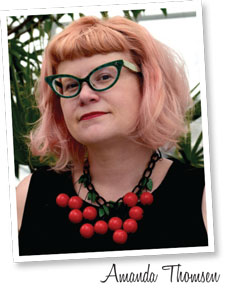1/1/2019
The One About Milkweed & Sam Kinison
Amanda Thomsen

It’s summer and I’m working an “Ask the Garden Expert” booth somewhere near downtown Chicago. It’s hot, humid and sweaty and a human walks up to my booth to complain that she planted her small, urban front yard with native plants, but it seems that insects are eating them all and there are UNSIGHTLY HOLES IN THE LEAVES and how can she stop that from happening?
Although internally I begin to yell like Sam Kinison (which is a dated, but very accurate, reference), I didn’t actually yell like Sam Kinison because this lady is really the ideal consumer, right? Someone sold this lady the idea that natives were the right thing to do; she just wasn’t given all the information (or wasn’t able to grasp it at the time) that she’d be the host of her own tiny ecosystem, with all the insects and wildlife that comes with that. She somehow got excited about natives enough to replace her front yard landscaping with them; she just doesn’t grasp the full picture yet. And who among us is even selling the full picture?
Hey, I know actual plant people “get” natives, but I also know that natives tend to not be bestsellers unless you’re a specialized kind of garden center. There’s a big gap between what people-who-sell-plants believe and what people-who-sell-plants sell. I think a large part of that is because we all need more naps, in general. We’re tired from leading customers this far down the Panicum path, adding even more customer education on top of that seems like too big of an ask. We’re great at selling the plants that sell themselves, the ones in bud and bloom or the ones with a national marketing campaign behind them. Selling a straggly native that hates being in a pot is a tough sell from the get-go.
Growing natives comes with a whole different maintenance regime than the homeowner has ever done before; suddenly bugs are a positive after years of being a nuisance. How do we sell a plant, look the customer square in the eye, smile and say, “Oh you are going to get SO MANY BUGS with this plant!” And have the customer: 1) Not run away from you; 2) buy the plant; and 3) check that plant for praying mantis ootheca with exuberance.
I think there’s a gap in the understanding that natives are the right thing to grow, but much of the public may not understand WHY they’re the right thing to grow. For years, we focused on their water-wiseness and not the total package. We all really got behind milkweed and, even though Monarch numbers are still in the tank, there’s little doubt that we moved the needle on educating the public on the how and the why of milkweed. Now it’s time to expand that kind of education. If we can get this many people to grow milkweed in their front yards, really, the sky’s the limit (because milkweed isn’t the most front-yardy plant).
And I’m not here with a ton of answers, but I can provide this: We sell the plants we love when we try, every time. With educated staff that has had a chance to grow natives themselves and got to witness the wonder that is Pycnanthemum muticum, I dare you to not sell a rack of them.
Use your newsletter and social media to educate about different kinds of bees, pick an insect and a plant of the month, talk about how to make a bug hotel (or sell them) and continue to push the good plants. Your ecosystem and your customers are counting on you.
Amanda Thomsen is a funky, punky garden writer and author. Her blog is planted at KissMyAster.com and you can follow her on Facebook, Twitter AND Instagram @KissMyAster.